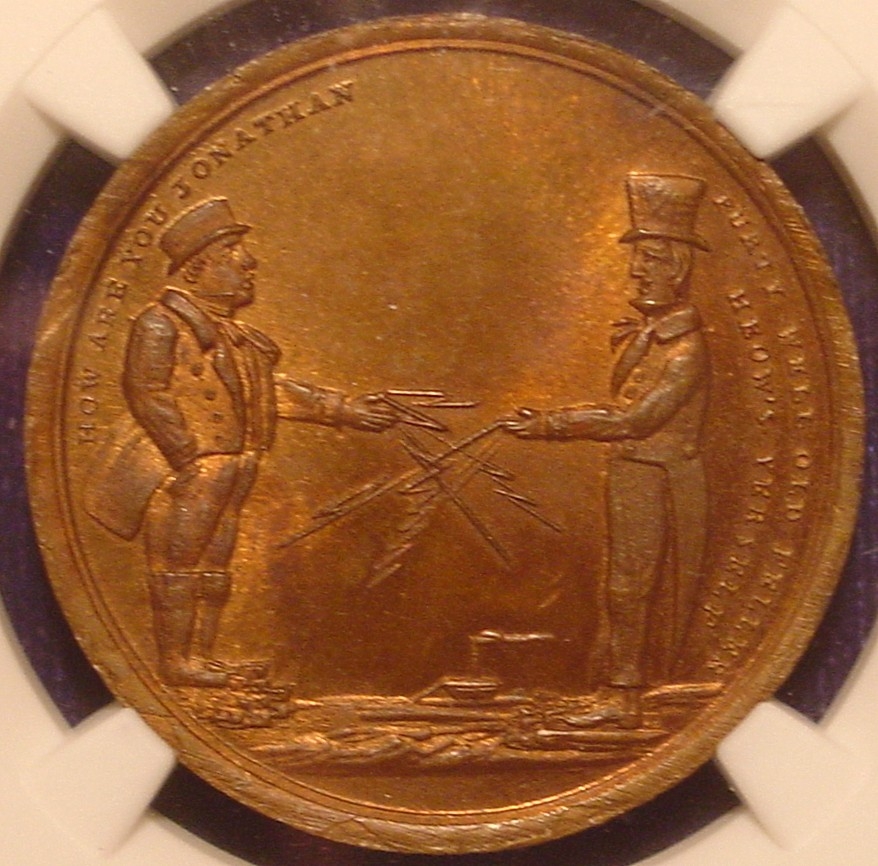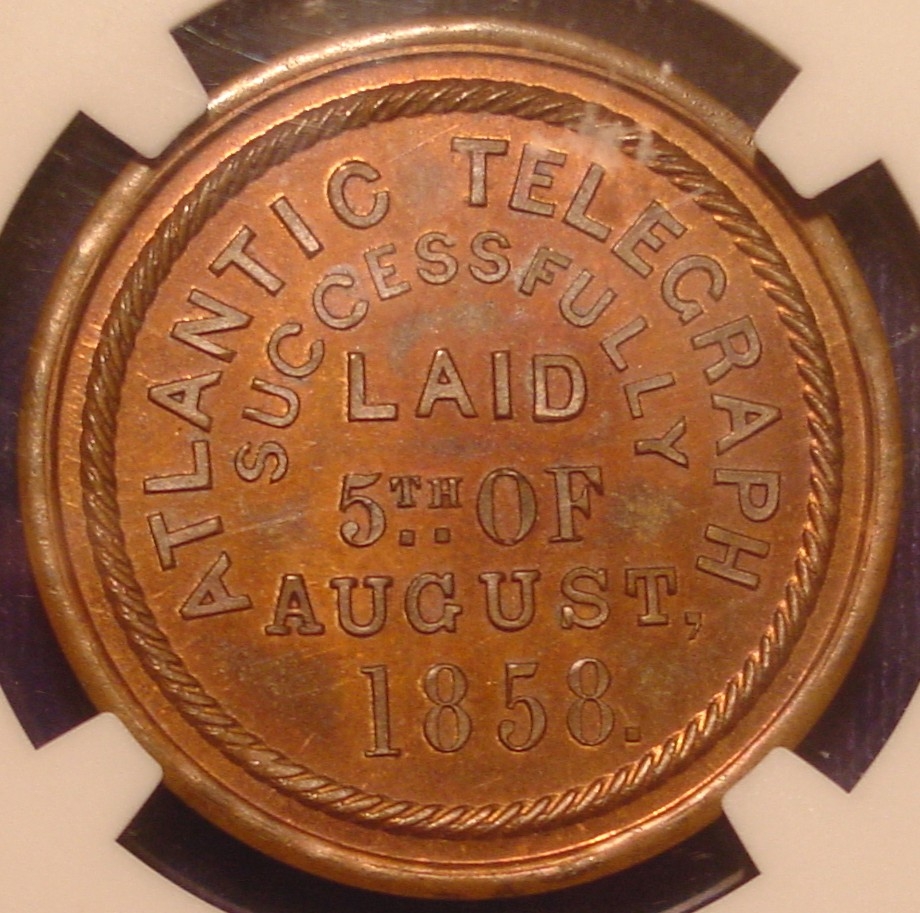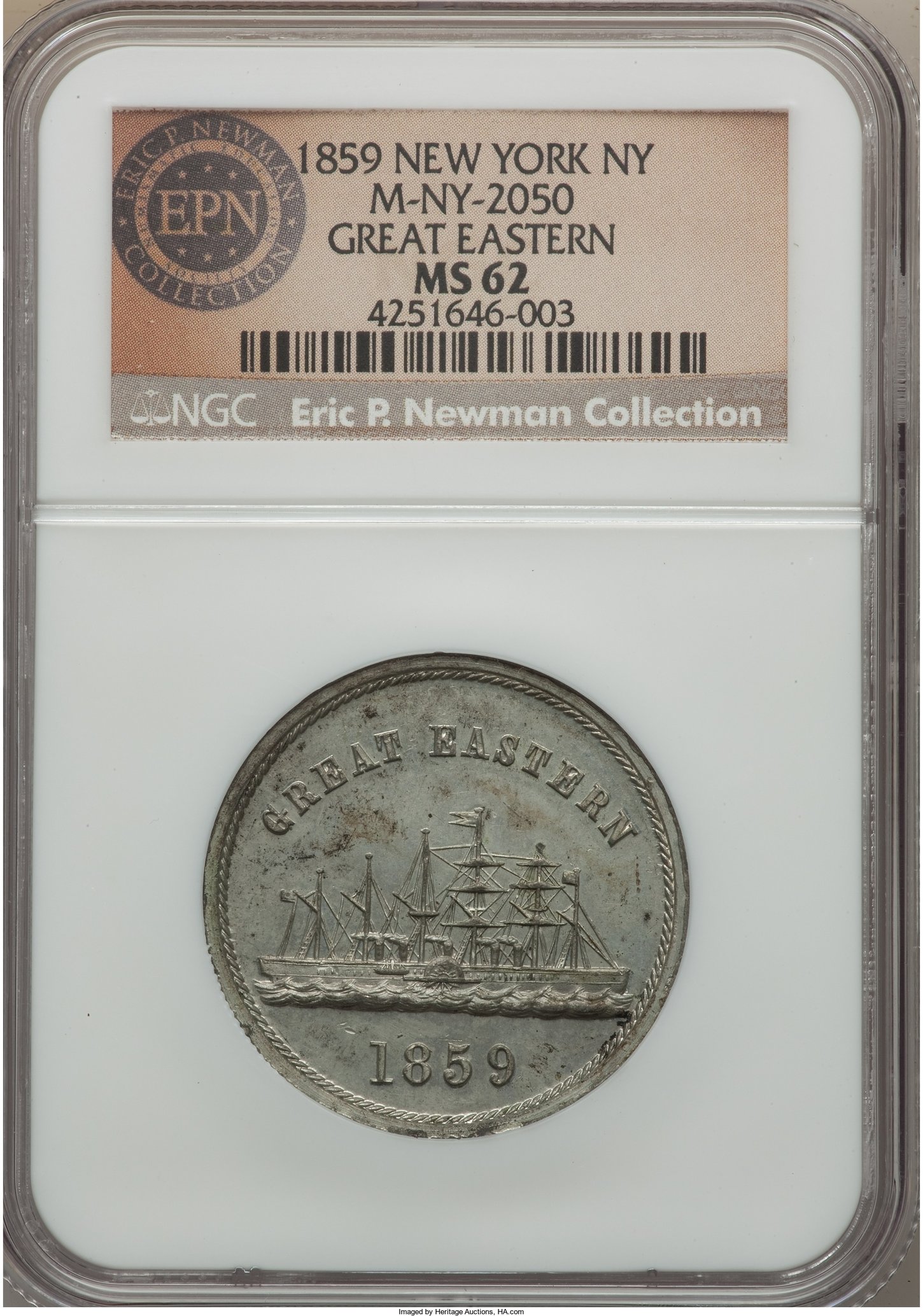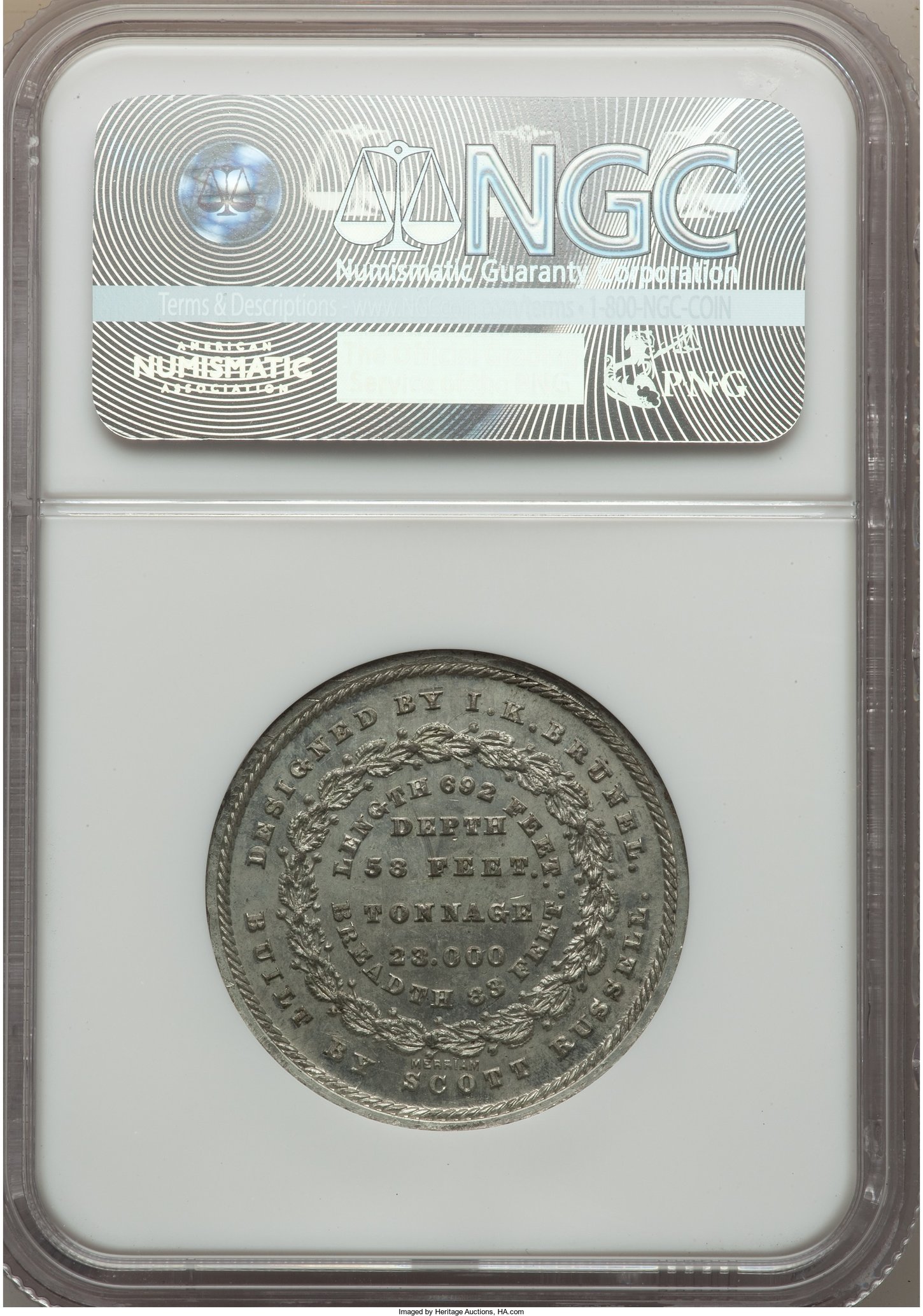The First Atlantic Cable Medalet by George Lovett
One of the great things about tokens and medals is that many of them have a great story to tell, unlike many coins which often have no more than a date, mint mark and mintage figures. Here the story of the first Atlantic cable which was immortalized by medalet executed by the 19th century die maker, George Lovett.


Those of us who live in the modern world can barely comprehend how time consuming and difficult it was to spread information across the globe 160 years ago. In the 1500s it took sailing ships months to complete the trip between Europe and America. Steam ships reduced that time to ten days when the conditions were ideal, but the virtually instantaneous transmission of information that we enjoy today was only a dream.
In 1839 William Cooke and Charles Wheatstone introduced the first working telegraph. As early as 1840, Samuel F. B. Morse, whose telegraph code revolutionized the industry, envisioned the concept of an undersea Atlantic cable that would connect America and Europe. In 1850 the first cable was laid between England and France.
That same year there was a proposal for an undersea cable between Newfoundland and Nova Scotia. A telegraph engineer, Frederick Newton Gisborne, picked up on the idea and formed a company to execute the project. He obtained a grant from the Nova Scotia legislature, but by 1853 his company was bankrupt. He was arrested for debt and lost everything.
In 1854 Gisborne met Cyrus West Field who invited the engineer to his home to discuss the Newfoundland – Nova Scotia telegraph cable project. Field had a far more ambitious project in mind. He proposed a cable that stretched not only between the two North American entities, but also across the Atlantic between America and Europe.
Field was an investor and an innovator, but he knew nothing about undersea cables. He began his research by consulting Samuel Morse and the pioneer American oceanographer, Mathew Maury, and promoted the New York, Newfoundland and London Telegraph Company to raise capital and support for the project. Later he sold shares of the Atlantic Telegraph Company to American and British investors and convinced both the American and British Governments to give him funding.
The first part of the project began in the summer of 1855 with a laying of cable in the Cabot Strait, which is in the Gulf of Saint Lawrence between Newfoundland and Nova Scotia. The cable was broken during storm which brought that first attempt to an abrupt end. The workmen were able to complete that that leg of the project the following summer.
The laying of the trans-Atlantic cable was far more challenging. The plan was for the British and the Americans to lay the cable using converted warships, HMS Agamemnon (British) and the USS Niagara (American). The HMS Agamemnon set out from the southwest coast of Ireland on August 5, 1857. The cable broke on the first day, but the crews were able to retrieve it. After it broke a second time, the project was abandoned for the year.
In the summer of 1858, the two sides conducted some practice runs before they met in the mid-Atlantic. The cable was spliced between the ships and then each ship set sail for their respective coastlines. Unfortunately the cable broke three times. After the last break occurred after each ship had laid about 200 nautical miles of cable. After that last failure both ships when back to Queenstown, Ireland to regroup.
On July 17 the ships set out again to complete the cable. Few of the crew members were optimistic that the project would succeed, but this time the fates were with them. The middle splice was completed on July 29 and the Niagara arrived in Newfoundland on August 4. The Agamemnon made the coast of Ireland the next day.
On August 16, 1858 the first official message, which was not technical in nature, was sent over the cable. It read, “Europe and America are united by telegraphy. Glory to God in the highest, on earth, peace and goodwill toward men.” This was followed by a message from British Queen Victoria to the American President, James Buchanan. It read in part, “an additional link between the nations whose friendship is founded on their common interest and reciprocal esteem.”
Buchanan responded with, “It is triumph more glorious, because far more useful to mankind than was ever won by conqueror on the field of battle. May the Atlantic telegraph, under the blessing of Heaven, prove to be a bond of perpetual peace and friendship between kindred nation, and an instrument destined by Divine Providence to diffuse religion, civilization, liberty and law throughout the world.” In New York City the news of the Atlantic cable was heralded by a salute of 100 guns, the ringing of church bells and the decoration of the streets with flags, but the joy would not last.
It was difficult to decipher the messages because the signals from the cable were weak. Queen Victoria’s message containing 98 words took 16 hours send. Furthermore the two senior electrical engineers who were in charge of operations on the American and British sides had very different ideas about how the cable should be operated. The British Lord Kelvin and the American Wildman Whitehouse (And no I did not make up Mr. Whitehouse’s first name, Wildman, nor was it a nickname.) could only communicate by using the cable itself.
Lord Kelvin believed that the cable could be operated using low voltage signals that were captured and amplified using a device that he developed, the mirror galvanometer. That device sensed a low level electric current by deflecting a light beam with a mirror. Using that technology Lord Kelvin believed that the Morse Code could be deciphered from the low voltage signals.
Wildman Whitehouse, who was a medical doctor, was a self-taught electrical engineer. Whitehouse believed that messages sent by the cable should be driven by a high voltage enhanced by induction coils. This resulted in transmissions that were too strong the mirror galvanometer. Whitehouse’s solution was to disconnect the mirror galvanometer on the British end and replace it with a telegraph recorder that he had invented.
Whitehouse’s high voltage transmissions caused the cable to fail completely, and he was blamed for the failure of project. Since then historians have argued that Whitehouse’s actions only sped the first cable’s demise. The cable would have failed anyway because of insolation deficiencies and improper handling during the time that it was installed.
This initial failure did not discourage Cyrus Field. He would raise the capital for another cable in 1864, and in 1866 the first successful trans-Atlantic was laid and become fully operational.
Despite the rapid failure of the first trans-Atlantic cable, it was celebrated by a 19th century medalet designed by George Lovett. The obverse features two male figures reaching out to each other with bolts of electricity between them. The figure on the left, who is British, has a caption above his head that reads, "How are you Jonathan" (sic). The figure on the right, the American, dressed in a top and tails, responds "Purty well old feller. Hbow's yerself" (sic). The reverse reads, “Atlantic cable successfully laid 5th of August 1858.” This is surrounded by circle which appears to be a cable.
One writer commented that Lovett produced the dies for this medalet despite the fact that cable failed so quickly. Perhaps Lovett began to cut the dies as soon as he heard about the first messages that came over cable and decided to finish the project despite the failure.
Comments
Thanks for the write up, Bill. A little over 150 years since the first successful Atlantic cable, and I can turn on skype and talk to the wifey who happens to be working in central Africa. Times have changed,, a bit.
CRO sold a similar medal to this one in 2008:
coinraritiesonline.com/index.php?page=ad_detail&id=114&year=2008
An authorized PCGS dealer, and a contributor to the Red Book.
Stunner Bill! Lovett to see that one in hand!
Best, SH
Thanks Bill, Great Medalet and Story.
Have been an amateur radio operator for 45 years and have always been fascinated with communications technology.
We have done a lot to advance digital communications and the cellular technology that we take for granted today.
I grew up in the town where it came ashore. The Cable House is still standing. I have a book with photos (real photos pasted in) that chronicles the event.
That is a great token in beautiful condition along with some nice history Bill. Given that 99% of international data today is carried by submerged cables and Google, Facebook and others are building more, it's hard to overstate how important this technology is. It's also amazing how things like international video calls were difficult a generation ago are a part of everyday life carried by these cables today.
How was this medalet distributed? Did Lovett sell them himself or have others handle that?
On a side note, I've been thinking about whether we should have more recent tokens to celebrate modern inventions. For example, 2017 is the 10th anniversary of the iPhone which has also completely changed the way people live.
Great article Bill. I had no idea there were so many attempts at laying a trans-Atlantic cable.
IIRC, it was Brumel's white elephant of a vessel, the Great Eastern, that managed to lay the first successful cable, as it was the only ship large enough to carry the enormous cable spools required. I wonder if there is a medal or token featuring that ship?
Cool piece.
Looking for Top Pop Mercury Dime Varieties & High Grade Mercury Dime Toners.
Great medal and thanks for the interesting piece of history Bill... I believe there could be a great book written about coins/medals and accompanying history... Would likely interest many more than just numismatists... and almost certainly create some new collectors. Cheers, RickO
Here is one by Joseph H. Merriam:


Dead Cat Waltz Exonumia
"Coin collecting for outcasts..."
Nice write up, Bill.
The Atlantic Cable medalet is one of the great designs from the years just before the Civil War. I remember when I bought my first edition of Russ Rulau's U.S. Merchant Tokens 1845-1860 and was blown away by some of the the strange and bizarre designs, including the Atlantic Cable design, which I had never seen before. Very cool stuff.
My example has no mint red, but I'll let that slide.
Your excellent post on the Lovett Atlantic Cable medalet came up on my Google feed yesterday, and I isigned up for this forum to give a little more information on these cable pieces.
I run the http://atlantic-cable.com research website on subsea cable history, and I have a page on medals and tokens arranged in chronological order:
http://atlantic-cable.com/Medals-Tokens/index.htm
If anyone here knows of any that I'm missing, please let me know. Contact info is on every page of my site.
On a related but somewhat different theme, I also have a comprehensive page on Atlantic cable broadsides and lithographs:
http://atlantic-cable.com/Ephemera/Broadsides/index.htm
Comments and feedback welcome!
Bill Burns